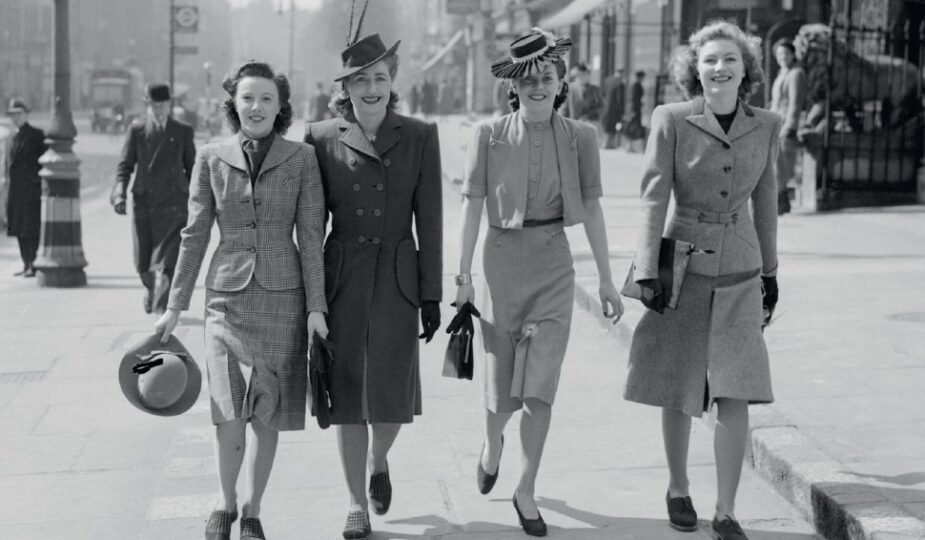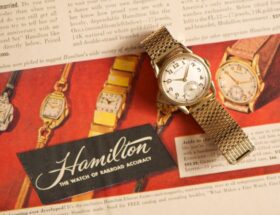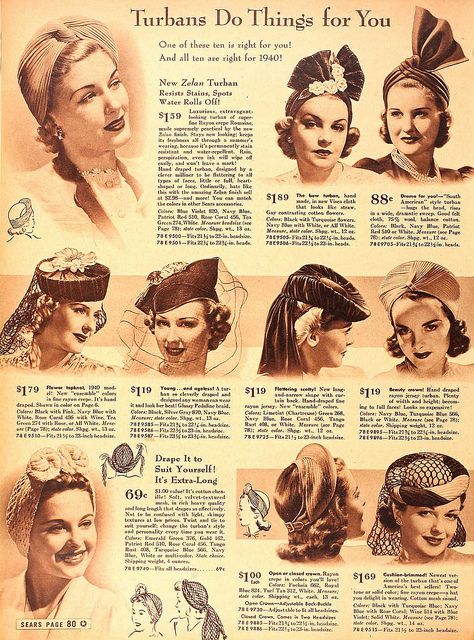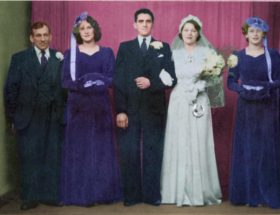1940s Rationing - Utility Clothing Fashion and Costume History
- Uniforms and Patriotic Fashion Looks
- Rationing of Goods
- Clothing, Cloth and Footwear Rationing
- Limited Coupons to Spend
- Non Rationed Items
- 1942 British Civilian Clothing Order CC41
- Clothes of War Siren Suit
- Make Do and Mend
- Knitting in the War
- Stockings
- Make Up 1940s
- Hair 1940s
- Dancing
- After the War the 'New Look' of 1947
- New Times, New Look
- For colour images of 1946 fashions see my Tailleur Fashion Plates page.
Uniforms and Patriotic Fashion Looks
During the Second World War Paris produced restrained clothing to match the economic atmosphere. The general wartime scene was one of drabness and uniformity, continuing well after the war finished in 1945. There was an austere atmosphere and people were encouraged to 'make do and mend.'
Uniforms were seen at all civilian social occasions from cinemas, weddings, restaurants to gala events. It was impossible to go anywhere without being aware of war as uniformed men and women in auxiliary services were an everyday fact.
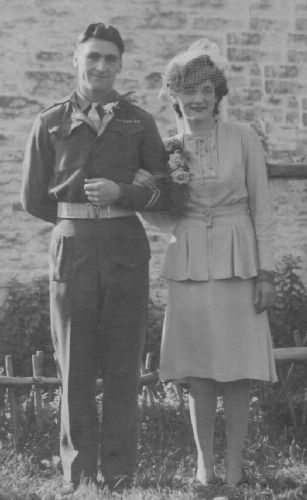
Jim and Connie Newbury my maternal aunt and uncle at their marriage in 1945 shortly after he returned home from World War II.
She wears a powder blue silk and wool crepe mix suit in a fashionable military style typical of the era.
Grooms usually married in their service uniform.
All the fripperies of fashion dressing pre-war were now thought of as very bad taste and simplification of style became essential if a woman wanted to appear patriotic.
The silhouette became refined and unadorned and consisted of a boxy square shoulder padded jacket and short straight skirt. Clothes had to be practical and restrained.
They had to work in all situations and give free movement. As wool had been used for uniforms for all the services there was shortage of wool and steps had to be taken to ration clothing for civilians as they were finding it impossible to get goods at all.
Rationing of Goods
Every type of cloth was short worldwide so material was severely rationed. Rationing was very strict in the UK and operated on a strict coupon system that for clothing started on Whit Sunday on June 1st 1941. A similar system was set up in America in 1942.
You are reading an original Utility Clothing During Rationing article by Pauline Weston Thomas at www.fashion-era.com ©
Food Rationing
Food rationing had started early in the war in January 1940 and rationed goods were frequently added to a growing list. So considerable restrictions were already in hand by May 1940. The weekly allowances of foodstuffs for each adult were:
Food Rations for 1 Week for 1 Person
- 4oz bacon or ham
- 8oz sugar
- 2oz tea
- 2oz jam spread
- 1oz cheese
- 1 shilling's worth of meat
- 8oz fats of which only 2oz could be butter
- Later sweets and tinned goods could be had on a points system.
- Bread was not rationed until post war in 1946.
It's not surprising then to realise that the nation was fitter and slimmer than at any other time in its history. If you lay out this amount of food on a plate it is quite shocking to see how little there is. For example 2oz of tea is equivalent to about 20 teabags which would make about 3 uses a day. An ounce of cheddar cheese, an average finger, is a snack nibble by today's standards.
Many people supplemented their food with eggs from chickens kept on a scrap of land. Local poached rabbits and hares and fruits and vegetables grown in allotments eked out meagre resources. Fruit became as exotic as truffles and tinned and dried goods supplemented diets.
People were healthy and often slender.
Clothing, Cloth and Footwear Rationing
Details of the rationing was announced in newspapers and women's magazines. The detailed message was in simple language for the masses to understand without any misunderstanding. If only the edicts of politicians and government were so simply stated today. It read:
Rationing Of Clothing, Cloth and Footwear From June, 1941 Rationing has been introduced not to deprive you of your real needs, but to make more certain that you get your share of the country's goods - to get fair shares with everybody else. When the shops re-open you will be able to buy cloth, clothes, footwear and knitting wool only if you bring your food ration book with you. the shopkeeper will detach the required number of coupons from the unused margarine page. each margarine coupon counts as one coupon towards the purchase of clothing and footwear. you will have a total of 66 coupons to last you a year; so go sparingly. you can buy where you like and when you like without registering.
Limited Coupons to Spend
This meant that women were forced to wear clothes that they had in their wardrobes before the announcement, adding items only as if essential.
The coupons were also reduced as the war progressed. Mid war they fell to 48 a year and by 1945 clothing coupons were as low as 36 a year. The scheme continued to issue coupons until 1949 with all forms of rationing ended in 1952.
One aspect that never seems to be much accounted for is the fact that even with the coupons some women and families were simply too poor to buy new clothes at all.
To some having the coupons made no difference as money was still needed to pay for the goods. Inevitably a black market arose in coupons and vast numbers of books, about 700,000 became lost or stolen in the early part of the scheme until the government issued new rules which forbade the detaching of coupons. New rules meant coupons had to be stamped in the book and detached only at the point of sale.
You are reading an original Utility Clothing During Rationing article by Pauline Weston Thomas at www.fashion-era.com ©
Here's a list showing the items as rationed for women and girls.
| Item Of Clothing | Women | Girls |
| Lined mackintosh or coat over 28" | 14 | 11 |
| Under 28" short coat or jacket | 11 | 8 |
| Frock, gown or dress of wool | 11 | 8 |
| Frock, gown or dress of other fabric | 7 | 5 |
| Bodice with girls skirt or gym tunic | 8 | 6 |
| Pyjamas | 8 | 6 |
| Divided skirt or skirt | 7 | 5 |
| Nightdress | 6 | 5 |
| Dungarees or overalls | 6 | 4 |
| Blouse, shirt, sports top, cardigan or jumper | 5 | 3 |
| Pair of slippers, boots or shoes | 5 | 3 |
| Other garments including corsets | 5 | 2 |
| Petticoat or slip, cami knickers or combinations | 4 | 3 |
| Apron or pinafore | 3 | 2 |
| Scarf, gloves, mittens or muff | 2 | 2 |
| Stockings per pair | 2 | 1 |
| Ankle socks per pair | 1 | 1 |
| 1 yard wool cloth 36"wide | 3 | 3 |
| 2 ounces of wool knitting yarn | 1 | 1 |
Non Rationed Items
In addition to the items listed there were goods that could be bought without coupons such as small items for babies under 4 months old. Boiler suits, workmen's bib, brace and overalls, hats and caps, sewing thread, mending wool, mending silk, boot and shoe laces, tapes, braids, ribbons and other fabrics less than 3 inches in width, elastic, lace, lace net, sanitary towels, braces, suspenders, garters, hard haberdashery, clogs and black out dyed cloth were all ration free.
Coupons were not needed for second hand articles. Retailers had a notice especially directed at them.
Special Notice To Retailers
Retailers will be allowed to get fresh stocks of cloth up to and including June 28th of other rationed goods up to and including June 21st WITHOUT SURRENDERING COUPONS.
After those dates they will be able to obtain fresh stocks only by turning in their customer's coupons. Steps have been taken in the interest of smaller retailers to limit during the periods the quantity of goods which can be supplied by a wholesaler or a manufacturer to any one retailer however large his orders. Further information can be obtained from your trade organisations.
1942 British Civilian Clothing Order CC41
Rationing was severe and where economies in designs could be made they were. In 1942 under the Civilian Clothing Order the British government introduced sumptuary laws designed to give weight to the Utility scheme.
The laws made it illegal and unpatriotic to spend time embellishing clothing for sale, and forbade manufacturers using the CC41 label shown in the header from using fancy trimmings, unnecessary buttons, extra stitching or tucks or pleats or pockets more than was essential to function.
Incorporated Society of London Fashion Designers CC41
To boost morale, the Incorporated Society of London Fashion Designers led by Captain Molyneux, Norman Hartnell, Digby Morton, Victor Stiebel, Angèle Delange, Peter Russell, Madame Bianca Mosca and Hardy Amies also created 34 smart Utility Clothing designs in 1942. They were officially approved by the Board of Trade and a selection was mass-produced.
Finally they were finished off with the official and now famous CC41 (Clothing Control 1941) label designed by the commercial artist Reginald Shipp.
Utility designs followed the square shouldered and short skirted fashions of the war era whilst sticking to the strict regulations for minimal cloth usage. Buttons were limited to three and turn back cuffs were eliminated.
Skirts some 19 inches from the ground were usual. Right Standard utility suit designed by the Incorporated Society Of London Fashion Designers.
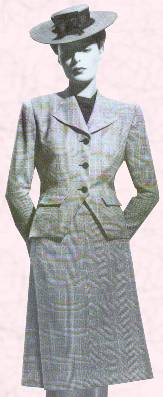
Even within the Utility scheme there were couture garments for those who could afford them, but they still used coupons. The wealthy also had their uniforms tailored at the best tailors rather than wear standard issue. For lots more colour images of fashions of 1946 see my Tailleur Fashion plates page.
You are reading an original Utility Clothing During Rationing article by Pauline Weston Thomas at www.fashion-era.com ©
Clothes of War
Fashion items that became popular were the wedge sole shoe, the turban, the siren suit and the kangaroo cloak. The turban equalised people of all sorts. It began as a simple safety device to prevent the wearer's hair entangling in factory machinery.

It doubled as a disguise for unkempt hair which women had less time to attend to being so busy running homes, jobs and giving extra help wherever they could.
Here are more 1940s hairstyle sketches.
Siren Suit
Siren suits were the original jumpsuit and the all enveloping sometimes tartan cloth garment was a huge hit especially at night when sirens called citizens to the air raid shelter for cover. With its quick zippered front individuals could wear the suit over pyjamas making it ideal for children.

The princesses Elizabeth and Margaret both owned siren suits as did Winston Churchill and others.
The siren suit was practical and warm in draughty situations. Later in the 1960s it was developed into evening wear in slinky Pucci prints.
Over the siren suit some would have donned a Kangaroo cloak coat so called because of its huge roomy kangaroo pockets.
The oversized pockets were ideal to stack with essential items as they ran through the house to an air raid shelter.
The severe shortage of leather meant that other thick sole materials such as cork was used.
The wedge sole was clumpy, but sturdy and wearers could walk for miles as the wedge stopped the hard road from making feet sore. They also lasted a long time and needed minimal repair as did clogs which were ration free, but noisy in wear.
'Make Do' and 'Mend'
Women were encouraged to 'Make Do' and 'Mend'. A 'Mrs. Sew and Sew' featured in advertisements in women's magazines and propaganda cinema clips promoted the idea of recycling textiles.
To working class women who had always had to make do and mend this was all rather patronizing and nothing new. Pillowcases would be turned into white shorts for summer. Wedding dresses would be worn several times, borrowed by sisters and friends, until the original 1939 bride in desperation for new items, remade the dress up into underwear, French Knickers or nightgowns.
The only way to have feminine underwear was to sew it yourself. Skirts were made from men's old plus fours or trousers. Cast offs would be made into children's clothes. Collars would be added and trims applied all to eke out a limited wardrobe. Women who could sew dresses had trouble getting hold of fabrics so they used everything from industrial blackout cloth to parachute silk or the harsher new parachute nylon.
Blankets were used to make coats and old voluminous swagger coats cut into smaller garments. Pillowcases were trimmed with lace and made into blouses. Nothing was wasted and even milk top discs were covered in raffia and made into handbags or accessories.
Knitting in the War
Everyone hand knitted and knitted mitts and scarves and socks made up in open lacy patterns stretched yarns even further. The finer the yarn the more knitwear a person could produce, but it was mainly expert knitters that used very fine silky Mercerised cotton yarns.
Wool socks were unravelled to have the yarn intermixed with random colours in fair isle designs often to make short waist cardigans or V neck sleeveless waistcoats for either sex.
You are reading an original Utility Clothing During Rationing article by Pauline Weston Thomas at www.fashion-era.com ©
Lorraine and Evan, guests at a wedding in 1947.
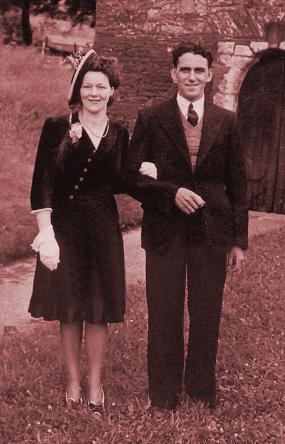
They are still on rationed clothes after the end of the war. She wears a short black velvet dress and pancake hat.
Lorraine said she bought the dress from her sister-in- law for ten shillings because by the end of the war she had no other dress left to wear.
Lorraine looks quite beautiful and very smart considering the circumstances.
Evan wears a knitted fair isle waistcoat beneath his well-worn wool suit bought in the autumn of 1939 for their wedding.
They brought forward their wedding when they heard war had been declared, wanting to be together and believing two could live as cheaply as one. Lorraine heard war announced over the radio on a bus, when traveling home to South Wales from London.
She told me, they 'knew' something was up when sandbags appeared everywhere! So many of the girls originally from the countryside but working in London, just packed their bags and went back home.
Stockings
Stockings of all types were scarce. Not even rayon stockings were readily available. Women were encouraged to wear ankle socks. Stockings might be found on the black market and later in the war many befriended an American G. I. in the hope of a pair of the new nylon stockings.
Otherwise it was make do and mend again and in the case of stockings, make do with leg make up or gravy browning and get a friend to draw a straight line down the back of the leg.
Make Up 1940s
Face make up was in short supply and news of a fresh stock of well known branded lipsticks at the local chemist meant that the shop sold out within an hour.
Munitions workers were encouraged to wear make up as a protective barrier to the grit and chemicals they worked amidst. Women working in dangerous conditions were helped to keep up their morale and Max Factor officials from America visited munitions factories handing out the new pancake make up and lipstick.
Ponds cold cream, Vaseline and Vitapointe conditioning cream for hair were the few items usually available. Munitions workers often had skin that turned canary yellow if they handled lots of explosive materials.
Hair 1940s
There was never enough stock of anything, but women still did their best to look good and their hair was important to them. By day it was kept out of sight in a turban or knitted snood which stopped it getting caught in machinery.
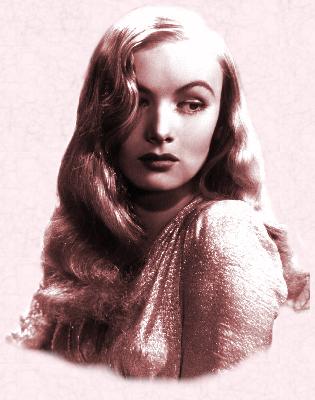
Generally hair still had some length as women could wash and dress their hair in ways which made them feel more feminine.
The Veronica Lake hairstyle was very popular as was peroxide bleached hair.
Glamorous styles with curls were preferred to the short styles of the twenties.
Some factories even installed hair salons to improve women's long term attendance.
During this era Princess Elizabeth popularised the wearing of a headscarf tied under the chin. Clothing, textiles and furniture marked with the Utility scheme met certain specifications and were of good design. By the end of rationing utility goods came to mean good quality. Many older citizens in their eighties still have damask tablecloths, blankets and easy chairs bearing the CC41 mark shown in the header are in good state.
You are reading an original Utility Clothing During Rationing article by Pauline Weston Thomas at www.fashion-era.com ©.
1940-1950 Dancing
The ragtime dances led the way for the equally outrageous Jitterbugging of the 1940s and the Jiving and Rock and Rolling of the 1950s.
After the War the New look of 1947
After the war the public became resentful and impatient when rationing was not relaxed on clothes. People were bitter because clothes were being made, but were exported in an effort to rebuild the British textile and wool economy.
Paris continued to produce exotic fashions, but America was developing a look of its own which was mainly found in Claire McCardell's designs. The American look was simple and classic and continues to have followers today.
New Times, New Look - Utility Clothing
Christian Dior's New Look of 1947 was frowned upon by both the UK and USA governments and people were discouraged from wearing clothes that 'wasted' so much fabric. The advice was ignored particularly by Princess Elizabeth and Princess Margaret who were soon wearing it because it had influenced their own designers.
Manufacturers read the public's need and their craving desire for newness and innovative change. They continued to manufacture replicas of the line and soon boxy uniform Forties fashions were consigned to the history books.
You have been reading an original Utility Clothing During Rationing article by Pauline Weston Thomas at www.fashion-era.com © Read more about Dior's New Look in fashion history on the page on Fifties Fashion. For colour images of 1946 fashion history see my Tailleur Fashion Plates page.
